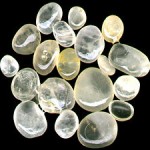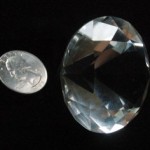The diamond that is not a diamond but is a diamond. It may not be De Boers but this stone can shine just as brilliant and comes in many sizes. It has an interesting history and is affordable for everyone, from free to reasonable. It can be found in many gift shops and gemstone stores. These beautiful gemstones are actually pure quartz crystals.
Known as Cape May Diamonds they are truly American gemstones made from 2000 to 3000 years of weathering it’s journey to the Atlantic ocean.
The diamonds begin their lives truly “in-the-rough” in the upper reaches of the Delaware River, in the areas around the Delaware Water Gap. Pieces of quartz crystal are broken off from veins and pockets by the swift-running waters of mountain streams that feed the river. Thus begins a journey of more than 200 miles that takes thousands of years to complete. Along the way, the sharp edges of the stones are smoothed as they are propelled along the river bottom. Eventually the stones come to rest on the shores of the Delaware Bay in South Jersey.(quote from May 2009: Doug Hunsberger (njmonthly.com))
A note from “Gems of The Beach” brochure. The Delaware Bay is 17 miles across with an underbelly of 26 miles. This makes for very strong currents in both the incoming and out going tides. This strong current strikes against the sides of the concrete ship “The S S Atlantus” which sunk in the bay. The quartz pebbles are then thrown ashore along with other debris such as fossil sharks teeth and Indian arrowheads. Larger stones come ashore in the winter months when the surf is much stronger.
A little history of the “S S Atlantus”
Remains of experimental concrete ship. One of twelve built during World War 1.
Proven impractical after several trans-Atlantic trips because of weight. Broke loose during storm
(June 1926) went aground. Attempts to free her were futile.
Go here to see the actual erosion of the Atlantus. http://www.concreteships.org/ships/ww1/atlantus/death.html
When polished and faceted, these Cape May gems have the actual appearance of real diamonds. Before the advent of modern gem scanning equipment, many a pawn broker was fooled by a “Cape May Diamond.”
The Kechemeche Indians were the first to find the fascinating and beautiful stones now known as “Cape May Diamonds.” The Indians came to believe that these curious stones possessed supernatural power bringing success and good fortune. The Kechemeche often used the the sacred gems in trading, especially the larger stones with no flaws.
One of the largest stones ever was presented to a settler by the name of Christopher Leaming by KIng Nummy, last chief of the Lenni-Lenape tribe. King Nummy had received the stone from the Kechemeche as a tribute to him and as proof of their faithfulness and loyalty. Mr Leaming had the stone sent back to his homeland, Amsterdam, Holland where a lapidary expertly cut and polished it into a beautiful gem.
You can follow the story of that gem in an article written in 2011. the following is a quote from that article.
“This unique and exquisite, flawless jewel, a gem of its kind, like the family in whose possession it has remained
from the earliest Colonial period, is inseparably interwoven with the history of New Jersey from the very beginning.”
http://www.capemay.com/magazine/2011/02/cape-may-diamonds/
The really good part about these diamonds is that you can take a holiday on the Jersey shore at Sunset Beach and go diamond hunting, they come ashore as small pebbles to large rocks (rare). From early spring to late fall, thousands of visitors enjoy wandering Sunset beach, New Jersey, searching for Cape May Diamonds. No success they can always pick up some at any of the gift shops on Sunset Boulevard.
Here’s to a fun weekend diamond hunting,



